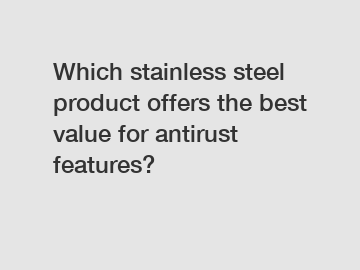Which stainless steel product offers the best value for antirust features?
Which Stainless Steel Product Offers the Best Value for Antirust Features?
Stainless steel is widely known for its corrosion-resistant properties, making it a popular choice for various applications. It is an alloy primarily composed of iron, chromium, and a small amount of carbon. The addition of chromium creates a passive oxide layer on the surface of the steel, which prevents corrosion by blocking oxygen diffusion to the metal's surface. However, not all stainless steel products offer the same level of antirust features. In this article, we will explore different stainless steel products and determine which ones offer the best value for their antirust properties.
1. Stainless Steel Grade 304.

One of the most commonly used stainless steel grades, 304, offers excellent antirust features in most environments. It contains 18% chromium and 8% nickel, which provides good resistance against corrosion caused by moisture and atmospheric conditions. Grade 304 is suitable for a wide range of applications, including kitchen appliances, food processing equipment, and architectural purposes.
2. Stainless Steel Grade 316.
Grade 316 stainless steel is highly corrosion resistant, making it an ideal choice for applications exposed to harsher environments, such as marine or industrial settings. It contains 16-18% chromium, 10-14% nickel, and 2-3% molybdenum, which enhances its resistance against corrosive agents like chloride ions. Grade 316 is commonly used for boat fittings, chemical processing equipment, and coastal architecture.
3. Stainless Steel Grade 430.
While grade 430 stainless steel offers decent corrosion resistance, it falls behind grades 304 and 316 in terms of antirust features. It contains 16-18% chromium, but no nickel, making it less resistant to oxidation and corrosion in moist environments. Grade 430 is commonly used in automotive trim and decorative applications but is not recommended for applications exposed to corrosive substances.
4. Stainless Steel Grade 201.
Grade 201 stainless steel is a less expensive alternative to grades 304 and 316, but it offers lower corrosion resistance. It contains 16-18% chromium and 3.5-5.5% nickel, which provides a moderate level of antirust properties. Grade 201 is commonly used for kitchen utensils, sinks, and automotive trim. While it may not be as durable as other grades, it still offers satisfactory resistance in many non-corrosive environments.
Conclusion.
When evaluating stainless steel products for their antirust features, it is crucial to consider the specific application and environmental conditions they will be exposed to. While grade 304 and grade 316 are generally the best options due to their high chromium and nickel content, other grades like 430 and 201 can still have their place in certain non-corrosive settings. It's essential to consult with experts in the field to choose the most suitable stainless steel product for your specific needs.
For high-quality stainless steel products with excellent antirust properties, contact us. Our team of experts will guide you through the selection process and help you find the best value for your requirements. Whether you need stainless steel for kitchen equipment, architectural purposes, or industrial applications, we have a wide range of options to meet your needs. Don't compromise on corrosion resistance – get in touch with us today!
If you want to learn more, please visit our website how good is stainless steel jewelry, does gold plated stainless steel tarnish, Girls Unicorn Wood Bracelet Necklace Set.


